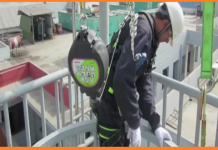| Required PPE: | |||
| 1. Safety glasses 2. Gloves (electrically insulated) | 3. Safety toe work boots 4. Protective clothing as needed | ||
| Required/Recommended Trainings: | |||
| Skilled electrical trade qualified and authorized | |||
| TASK | HAZARDS | CONTROLS | |
| Using improper equipment or method could result in bodily injury and increase shock potential | Use the right equipment for the task at hand. Follow applicable Electrical LOTO procedures. Options to use cable pulling machines in equipment room: 2K, 4K other EC Shop equipment/tools. | |
| Electric shock Bodily injury – strains Body or equipment entanglement in wire/cable Be aware that the fish tape may “spring” freely as it exits the conduit | Follow applicable EI-LOTO procedures. When it is not possible to de-energize the panel board or when pulling wire through a conduit that has energized conductors, use a fiberglass fish tape. Be aware of body positioning to prevent excessive strain. Ensure surrounding equipment and materials will not interfere with body movement/entanglement of wire. Use rubber insulating sheets or appropriate material to cover and protect energized parts. In all cases, wear proper PPE for the task (includes eye protection). | |
| Poor communication methods could result in bodily or equipment damage (STF’s, strains…) | Verify communication devices are functioning properly. | |
When using a pulling sock, tape only the end of the sock to the conductors. | Conductor may slip if the entire sock is taped. Pulling socks and metal fish tapes through conduit with existing conductors can be abrasive and damage existing wire insulation. | Use the correct tools and equipment for the job. | |
| Physical strain and fall potential is increased during the pull. | Do not rush the pull. Get assistance if necessary. | |
| Exposed wire ends can become energized or come in contact with energized parts | Tape off (safe off) wire ends | |
| Exposed wire ends can become energized or come in contact with energized parts | Tape off (safe off) wire ends | |





